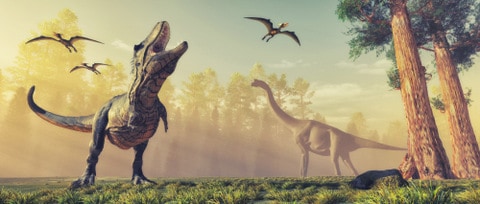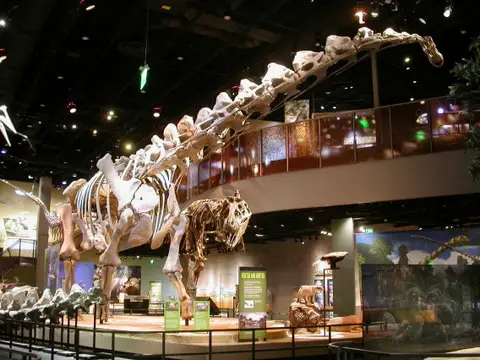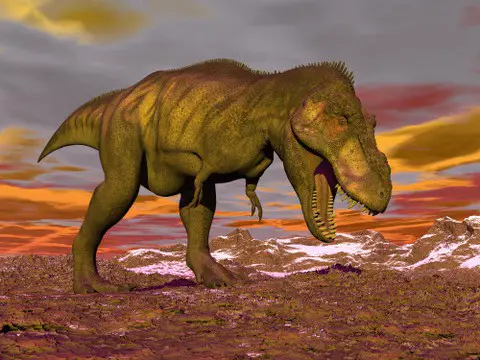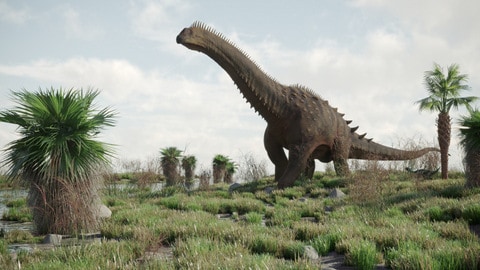Geological Surveys Indicate Tyrannosauridae And Other Predators Like Tarbosaurus Bataar Lived With Sauropods
What Sauropods Lived with T. Rex is a question that brings images of prehistoric titans roaming the Cretaceous landscapes, engaging in a life-and-death ballet. Imagine the thunderous footsteps of these behemoths echoing through ancient forests, a symphony of survival underscoring the era of dinosaurs. The late Cretaceous period was a time of colossal clashes and serene coexistence. Among the giants that shared the stage with T. Rex, the Alamosaurus stands tall in the fossil record, hinting at a complex ecosystem where predator and prey dynamics were as intricate as they were intense.

What Sauropods Lived With T. Rex?
The only long-necked sauropod likely to have lived with T. Rex is the Alamosaurus, one of the giant titanosaurs. Both dinosaurs existed in the Late Cretaceous period, and their fossils have been found in the Southwestern states of Colorado, New Mexico, Wyoming, Texas, South Dakota, Montana, and Utah. The Alamosaurus is the only sauropod known to have lived in this region during the Late Cretaceous.
Key Takeaways
- Sauropods, or long-neck dinosaurs, lived in the Mesozoic Era, reaching enormous sizes and living globally.
- Evidence suggests Sauropods like Brontosaurus, Apatosaurus, and Diplodocus could create supersonic cracks with their tails.
- Despite their size, Sauropods didn’t chew their food well; their digestion relied heavily on powerful stomach enzymes.
- Sauropods had an intriguing anatomy, their brain was 26 feet above their heart which weighed over 200 kg.
- Contrary to past beliefs, the Brontosaurus was found to be unique enough to be its own dinosaur classification.
- The Mamenchisaurus, Brachiosaurus, and Alamosaurus were among some of the largest Sauropods, reaching lengths over 30 meters.
The remarkable coexistence of the mighty T. Rex and the striking sauropods, including groups like Titanosaurs and specific species such as the Alamosaurus, was a noteworthy occurrence in the Cretaceous period of the Earth’s history. This time, along with the Jurassic period, witnessed some of the most significant evolutionary changes, with these fascinating creatures later immortalized in natural history museums worldwide.
Standout species such as the T. Rex did not exist in isolation—they shared their habitats with other formidable dinosaurs like the Triceratops and Velociraptors. Paleontology—the scientific study of the history of life—dedicates extensive resources to unearthing and examining fossils, the enduring remnants of these prehistoric animals.
The fossil record, a comprehensive index of once-living organisms, offers valuable insights into the intricate relationships between various species and their environments. It also allows us to plot these prehistoric organisms on the geologic time scale, illuminating their existence relative to major historical events, such as the mass extinction events that marked the end of certain geological eras.
Ultimately, our understanding of the Earth’s history and the course of evolution itself is enriched by investigating these long-extinct creatures. The notable existence of the T. Rex and sauropods during the same geological era serves as a testament to the remarkable diversity of prehistoric life and the dynamism of our planet’s past.
What’s the coolest and most interesting bit of trivia about dinosaurs to know? How about this: the Alamosaurus is the only long-necked sauropod that existed together with the T. Rex in North America. Expanding on that initial trivia is understanding Alamosaurus and T. Rex’s habitat when they existed together and listing a few other dinosaurs that lived in the same period and region. Let’s jump in and check this out.
T. Rex Stomped Around With Many Different Dinosaurs During The Late Cretaceous
The Tyrannosaurus Rex is one of the most famous dinosaurs, known to many through movies and dinosaur books. It is a carnivorous theropod characterized by having a large body, sharp teeth, and strong jaws.
During their time, the T. Rex lived together with other herbivores, carnivores, and omnivore dinosaurs. In this section, I’ll cover a bit more detail about the T. Rex, the Alamosaurus and list some of the other dinosaurs that lived with it during the Late Cretaceous.
The apex predator T. Rex is a well-known predator. In this article, I’ll discuss the likelihood of whether T. Rex would have hunted Alamosaurus, methods that the long-necked sauropod could have used to defend against the T. Rex.
I will cover a closer look at the habitat of the long neck sauropod, Alamosaurus, and T. Rex too. Let’s get started.
More About T. Rex and When it Lived
With all the Jurassic movies that have been released, you would think that the T. Rex lived during the Jurassic period.
Actually, T. Rex lived after the Jurassic period, which is the Cretaceous period. The T. Rex is known to be among the last known big dinosaurs which lived during Late Cretaceous.
And during this time, other dinosaurs coexisted with the T. Rex before finally going into massive dinosaur extinction.
The T. Rex lived 65 – 75 million years ago when the supercontinent, Pangaea, was already broken into two subcontinents. The T. Rex might have preyed on each other, but they are more likely to have attacked weaker dinosaurs in their habitat.
Its fossils have been found in the Southwestern states of Montana, Wyoming, South Dakota, and Colorado in the United States and Saskatchewan in Canada.
Tyrannosaurus Rex’s cladistic phylogeny shows that the T. Rex is derived from the Theropoda-Neotheropoda-Avetheropoda and up to the Coelurosauria clades and sits in the Tyrannosauroidea-Tyrannosaurinae clade as per studies in 2010 (Source).
Table 1 -T. Rex and Alamosaurus Match-Up
| Characteristic | Tyrannosaurus Rex | Alamosaurus |
|---|---|---|
| Size - length, height, weight | 35-42 feet long; 8-12 feet tall; 9-15 tons in weight | 98 feet long; 92-98 feet tall; 80-88 tons in weight |
| Type of Dinosaur | Carnivore, Theropod | Herbivore, Sauropod titanosaur |
| Preferred Habitat | Grassy plains, riparian forests, river deltas | Swamps, Rivers, Lakes |
| Where Fossils Found | Colorado, Montana, Wyoming, South Dakota, Texas, Utah, Canada | New Mexico, Wyoming, Utah, Texas |
| Intelligence | EQ Scale - 1.8-2.0 | EQ Scale - 0.2 |
| Defensive Physical Characteristics | Claws, tail | Neck, tail, size & weight |
| Offensive Physical Characteristics | Teeth, claws, large eyes, large nostrils | None |
| Characteristic | Tyrannosaurus Rex | Alamosaurus |
The Long-Necked Sauropod – Alamosaurus
The Alamosaurus was a long-necked sauropod that also coexisted during the Late Cretaceous with the T. Rex in North America. The two lived side by side for millions of years before the Cretaceous–Paleogene (K–Pg) Extinction event.
Interestingly, so far, the only species of sauropods to live with the T. Rex is the Alamosaurus.
There have been recent finds of sauropod trackways in Canada, which indicates that sauropods lived in the northern regions (Source), however as there are no Late Cretaceous skeletal remains of sauropods in Canada so far, I will consider only the Alamosaurus that lived in the Western U.S. where T. Rex was predominantly found.
The name Alamosaurus is derived from where its fossil was first found, in the Ojo Alamo sandstone formation in New Mexico known as the Kirtland Shale nowadays.
The Alamosaurus is a herbivore sauropod characterized by long necks and limbs. It is a titanosaur sauropod, and paleontologists believe that at least part of its neck, main body trunk, or tail had armor.
There is only one species of Alamosaurus, the Alamosaurus sanjuanensis. Its fossil remains are found in the Big Bend region of Texas, New Mexico, Utah, Montana. The size of sauropod dinosaurs and especially titanosaurs, is gigantic.
An Alamosaurus could reach 70 feet in height and weighed around 30 tons making it the biggest dinosaur known to have lived in North America. Meanwhile, the T. Rex is at most 20 feet in height. The Tyrannosaurus fossils in North America were also found in the same and nearby regions as the Alamosaurus, signifying that they had met each other when they existed. (Source)
The Alamosaurus is said to live in warm areas abundant with rivers and grasses, while the T. Rex is believed to inhabit humid open forests with nearby rivers and coastal swamps.
According to experts, their preferred environment’s similarities most likely led to them having shared the same habitat. Due to the predatory instincts of T. Rex, it is also possible that the T. Rex preyed on Alamosaurus despite the huge difference in their sizes. (Source)
Scientists suggest that sauropods and titanosaurs thrived during the later part of the Jurassic period in North America. Afterward, the sauropods declined in number and almost disappeared in this continent for a long time.
It was only during the late Cretaceous period when a certain sauropod, the Alamosaurus, prospered and coexisted with one of the late Cretaceous dinosaurs, the Tyrannosaurus Rex.

Key Types Of Dinosaurs That Lived With T. Rex
To fill out the picture, let’s look at other dinosaurs in the Late Cretaceous ecosystem of North America.
All of the dinosaurs are well-known for their distinct features, such as the Triceratops with its three horns or the Ankylosaurus with its club-like tail. The Styracosaurus is another dinosaur with a distinguishing feature; it has spikes protruding from the back of its head.
Some dinosaurs could be both bipedal and quadrupedal, like the Edmontosaurus, the Corythosaurus with a weird bony crest on top of its long head, and the Maiasaura known for its motherly instincts.
They are also accompanied by the large-eyed Pachycephalosaurus that is bipedal, just like the T. Rex.

The Late Cretaceous period lasted 35 million years, starting 100 million years ago and ending 65 million years ago in the mass extinction event. During this period, the dinosaurs that lived with T. Rex can be grouped into these types:
Herbivorous Dinosaurs:
- Sauropods – four-legged dinosaurs with long necks and long tails – Alamosaurus
- Ceratopsians – four-legged dinosaurs with horns and frills – Triceratops, Torosaurus, Styracosaurus (Canada)
- Ankylosaurs – two-legged armored dinosaurs with clubbed tails – Denverosaurus and Ankylosaurus
- Hadrosaurs – two-legged theropods that were plant-eating dinosaurs – Edmontosaurus, Saurolophus, Maiasaura
- Pachycephalosaurs – theropods with hard heads and bony crown – Pachycephalosaurus, Stygimoloch, Dracorex (Source)
Most of the dinosaurs that coexisted with them were just food for these carnivorous theropods.
The previously mentioned dinosaurs are all herbivores, while the T. Rex is among the largest meat-eating dinosaurs ever known. It easily makes the T. Rex the most dominant predator during their time.
Carnivorous Dinosaurs:
- Carnivorous theropods – Albertosaurus, Deinonychus, and Tyrannosaurus Rex
Omnivorous Dinosaurs:
- Smaller-sized theropods that ate meat and plants – Gallimimus, Ornithomimus, Troodon
Flying Reptiles
- Pteranodon, Quetzalcoatlus
————————————————————————————————
Related T-Rex Articles You Might Also Be Interested In:
7 Surprising Facts About Sue The Dinosaur- Most Complete T-Rex Fossil
Would A T-Rex Really Shake The Ground?
How Would A T-Rex Get Up After Falling?
————————————————————————————————
What Was the Likelihood That T. Rex Hunted Alamosaurus
When we examine the Alamosaurus, it’s easy to see that with their enormous size, it was nearly impossible for a single T. Rex to take one down.
It may be true, though, that as carnivores, these mighty predators had preyed on injured or younger Alamosaurus dinosaurs – or even worked in groups sometimes to attack larger ones. What proof do we have that a T. Rex hunted and ate the Alamosaurus?
Let’s take a look at fossil evidence of what other predators hunted sauropods in other regions and periods.
Did T Rex Eat Sauropods? – What the Fossil Record Tells Us
Dinosaurs as huge as the Alamosaurus have lots of meat in their bodies that are ideal food sources for carnivorous theropods like the T. Rex. Although sauropods, in general, are enormous, a theropod targeting sauropods is not an unusual case.
There is evidence suggesting that theropods do not get intimidated by larger dinosaurs and are actually willing to attack them. In the Paluxy river located in Texas, a set of dinosaur footprints seemed to show that a theropod was stalking a sauropod.
Their footprints are parallel with each other up to a certain point wherein the theropod started to have a missing footprint. (Source)
According to experts, it is highly likely that after stalking the sauropod for quite some time, the theropod attacked and bit the sauropod’s tail. The succeeding prints then showed a sad picture – the sauropod fossils indicate that the sauropod was struggling and stumbling due to being injured.
While this evidence could be a generalization about the theropods and sauropods, there is also hard evidence that shows a tyrannosaur has eaten the remains of an Alamosaurus.
In New Mexico, a paleontologist’s team discovered a tyrannosaur tooth together with an Alamosaurus vertebra. So yes, T. Rex ate Alamosaurus.
When it comes to whether a T. Rex hunted Alamosaurus, the fossil records can only indicate the possibility that a T. Rex might have attacked and fed on an Alamosaurus.
From the fossil record, it can also mean that a T. Rex might have just eaten an Alamosaurus carcass lying on the ground.
A full-grown T. Rex does not even reach one-third the height of an adult Alamosaurus. Because of this, the neck and head of an Alamosaurus are safe and out of reach from a T. Rex. Size could be all sauropods’ greatest strength, but they also have other characteristics that can help them escape ferocious attacks from predators like the T. Rex. (Source)
Just like the Alamosaurus, all sauropods are quadrupedal. It makes their bodies more stable than the T. Rex because they use four legs to balance themselves. As a result, they will not easily fall on the ground, which helps maintain their tall height as an advantage.
The Alamosaurus also has a long whip-like tail that the Alamosaurus can easily use for protecting itself against predators. It is also believed that the Alamosaurus, being part of the titanosaurs, has bony armor coverings in its body. It is beneficial in evading the sharp teeth and strong bites of the T. Rex.
Lastly, the Alamosaurus is not an aquatic animal, but as a sauropod, it can opt to float on very deep waters to escape predators due to its long limbs and extensive air sac system.
How Good a Hunter Was T. Rex?
The T. Rex was an apex predator, meaning that it was at the top of the food chain and had evolved teeth, claws, and physical agility to take down prey that is hunted. You can see a well-adapted predator from the skull fossils and skeletons, which was certainly a fierce and skillful hunter.
The T. Rex had some great physical hunting attributes. Enlarged nostrils gave it the ability to smell even better. The large eye sockets give paleontologists reason to believe that its eyesight was superior and helped in the hunting process.
If a T. Rex hunted the Alamosaurus, it could use its physical attributes to find and attack the Alamosaurus to devastating effect. The giant teeth could tear the flesh of the Alamosaurus, and the agility of the T. Rex would help it maneuver so it could fell the sauropod.
In terms of intelligence, the T. Rex was at a high intelligence range for large dinosaur predators. The Alamosaurus was and the low end.
In the 1970s, scientists created an EQ scale that aimed to measure dinosaurs’ intelligence by comparing the estimated brain size (take from the fossilized cavity of dinosaur skulls) vs. the weight mass.
T. Rex scores a 1.8-2.0 on the EQ scale (the scale is from 0.0 – 6.0), and sauropods like Alamosaurus are at around 0.2 on the EQ scale.
It’s likely that T. Rex, being the apex predator and having significantly high intelligence, could certainly hunt Alamosaurus effectively.
If you are interested to know more about dinosaur intelligence, check out my article Smartest Dinosaur Species – Hunters That Could Outsmart Its Prey.
How Could Alamosaurus Defend Itself Against T. Rex?
Even though T. Rex was a skillful hunter; that doesn’t mean Alamosaurus couldn’t stand its ground against the predator or prevent capture. The Alamosaurus had some things going for it, which allowed it to evade or escape from a T. Rex effectively.

Methods the Alamosaurus Could Escape From a T. Rex
If a T. Rex was hunting a long-necked Alamosaurus, there are few things the sauropod could do to prevent the T. Rex from getting close in the first place.
Some of the methods the Alamosaurus could effectively avoid being lunch for a T. Rex is:
● Herding – By staying close in groups, there is safety in numbers
● Escaping to deep water swamps, lakes, and rivers – keep the T. Rex away by swimming into deep water
Let’s take a closer look at these dinosaurs’ swimming ability and some natural protections the Alamosaurus had.
————————————————————————————————
Related Sauropod Articles You Might Also Be Interested In:
How Did Long Neck Dinosaurs Defend Themselves? 3 Key Defences
Where Did Long Neck Dinosaurs Live? A Global Snapshot
What Are Long Neck Dinosaurs (Types, Size, List)?
————————————————————————————————
The Swimming Abilities of T. Rex and Alamosaurus
It is also believed that the T. Rex had some swimming ability, although fairly limited and only in shallow water. In an old river bed, million-year-old scratch marks seemingly coming from a two-legged dinosaur like the Tyrannosaur indicate that it is propelling itself into water.
The scratch marks seemed to have been made when the dinosaur’s feet were scraping the bottom while moving in the water. Some experts believed that a T. Rex had been able to cross rivers by paddling short distances. Besides, it also has a relatively long tail and powerful legs that can be useful for its aquatic locomotion.
But considering the depths an Alamosaurus can traverse in water, it would be possibly harder for a T. Rex to catch up.
It was initially believed that sauropods, in general, are swimming creatures because their large weights must have been difficult to support on land. Paleontologists assumed that it would be better for them to be submerged underwater to support their body support.
But this was debunked when studies showed that prolonged submersion underwater could collapse these dinosaurs’ lungs and airways.
Later on, scientists discovered that all sauropods are equipped with an extensive air sac system that could let them float on water. It could let them swim safely because a floating body means that its lungs are free from underwater pressure.
Now, it is firmly believed that sauropods are primarily terrestrial (just like all dinosaurs!), but they can float in water for short periods. It is supported by discovered fossil trackways that depict possible semi-swimming sauropods or an unusual aquatic locomotion method.
Scientists thought the movement was unusual because scientists can visualize it as the sauropod having front limbs on the ground while their hind legs are floating in the water.
If you are interested in reading more about how sauropods evaded and defended themselves against predators, check out my article How Did Long Neck Dinosaurs Defend Themselves? 3 Key Defences which goes into detail about this.
Ways Alamosaurus Could Defend Itself Against T. Rex
There were a few key ways that an Alamosaurus could effectively defend itself from an attacking T. Rex. It could:
- Use its enormous weight to shove or step on an attacking T. Rex.
- Use its neck to shove or hit the T. Rex.
- Use its tail like a whip.
- As a titanosaur, parts of its body were covered in armor, protecting it somehow from the sharp teeth and claws of the T. Rex.
Simultaneously, the Alamosaurus used these tactics near water, the long neck sauropod could escape to deep water, and the T. Rex would have difficulties following.
Parting Shot
Given the ferocity of the Tyrannosaurus rex and the strength of the Alamosaurus, it can be a bit hard to pick which dinosaur would reign during an attack.
But imagining their circumstances during the Late Cretaceous period with both dinosaurs settling in habitats near rivers, the sauropods having various protective mechanisms, and the extent of both of their swimming abilities, I would say that the Alamosaurus had the greater edge.
Amazingly, we can start to piece together ecosystems of dinosaurs in a particular geographic area and contemplate how they lived together because of the fossil records.
It seems strange that Alamosaurus was the only sauropod to live in the Western states of North America during the Cretaceous period. Perhaps we will find evidence of other sauropods in the coming years. That would be exciting!
Frequently Asked Questions
What sauropods lived with T. Rex?
In Western North America during the Mesozoic era, there were several species of sauropods that lived alongside Tyrannosaurus rex. These included species such as Tarbosaurus bataar, as well as other members of the Tyrannosauridae family.
How did sauropods coexist with T. Rex?
Although T. rex and sauropods coexisted during the Upper Cretaceous period, they occupied different ecological niches. Sauropods were herbivorous, and their massive body size allowed them to browse on vegetation, while T. rex was a carnivorous theropod dinosaur that likely scavenged or hunted smaller vertebrates.
Were there any interactions between T. Rex and sauropods?
It is difficult to say for certain if there were direct interactions between T. rex and sauropods. However, evidence from fossilized bones suggests that T. rex chomped on sauropod carcasses, indicating that they may have scavenged on the remains of dead sauropods.
Which specific sauropod species are known to have lived alongside T. Rex?
While there is limited direct evidence, current research suggests that sauropod species such as Apatosaurus, Brachiosaurus, and Diplodocus could have coexisted with T. rex during the Late Cretaceous period.
What is the relationship between T. rex and Tarbosaurus bataar?
Tarbosaurus bataar, also known as the Asian Tyrannosaurus rex, is a closely related genus of tyrannosaurid dinosaur. It lived in Asia during the Upper Cretaceous period and is considered to be a close cousin of T. rex.
When did the coexistence between T. Rex and sauropods end?
The coexistence between T. rex and sauropods likely came to an end at the end of the Cretaceous period, about 66 million years ago, during the mass extinction event that wiped out the non-avian dinosaurs.
Which institutions have notable collections of T. Rex and sauropod fossils?
The Smithsonian Magazine and the American Museum of Natural History are two institutions that have notable collections of T. rex and sauropod fossils. Additionally, the Museum of the Rockies and the Geological Survey also house important specimens of Tyrannosaurus rex and sauropods.
Did T. Rex prey on sauropods?
While it is possible that T. rex may have hunted or scavenged on sauropods, the evidence is not conclusive. T. rex is more commonly associated with hunting smaller vertebrates and scavenging on carcasses.
What kind of teeth did T. Rex have?
T. rex had large, serrated teeth that were well-suited for tearing through flesh. These teeth were some of the most formidable among carnivores of all time.
Can I see T. Rex and sauropod fossils in museums?
Yes, many museums around the world, such as the American Museum of Natural History and the Museum of the Rockies, have displays of T. rex and sauropod fossils. These exhibits provide an opportunity to see the remains of these ancient creatures up close.
